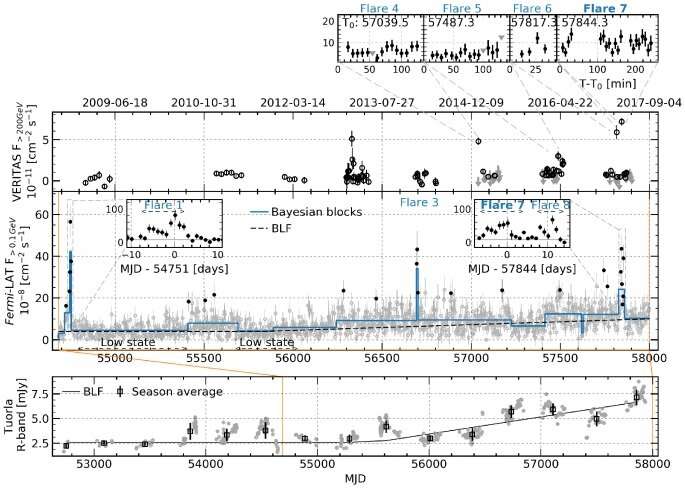February 18, 2020 report
Long-term multi-wavelength observations shed more light on blazar 1ES 1215+303

An international team of astronomers has performed a decade-long, multi-wavelength monitoring campaign of the blazar 1ES 1215+303. Results of this extensive study provide more insights into the nature of emission from this source. The research is detailed in a paper published February 10 on arXiv.org.
Blazars, classified as members of a larger group of active galaxies that host active galactic nuclei (AGN), are the most numerous extragalactic gamma-ray sources. Their characteristic features are relativistic jets pointed almost exactly toward the Earth. In general, blazars are perceived by astronomers as high-energy engines serving as natural laboratories to study particle acceleration, relativistic plasma processes, magnetic field dynamics and black hole physics.
1ES 1215+303, also known as Ton 605, ON 325, B2 1215+30 or S3 1215+30, is a blazar at a redshift of 0.13, detected in the very-high-energy (VHE) gamma-ray band in 2012. It exhibits a double-humped spectral energy distribution (SED), with the synchrotron peak between radio and X-ray energies and the high-energy peak at GeV−TeV energies. In 2014, it experienced one of the most luminous and large-amplitude flares seen from a VHE blazar.
In order to gain a more detailed view of the emission from 1ES 1215+303, a group of nearly 90 astronomers worldwide monitored the blazar from December 2008 and May 2017, using NASA's Fermi Gamma-ray Space Telescope and the Very Energetic Radiation Imaging Telescope Array System (VERITAS) in Arizona. The campaign investigated the broadband emission of 1ES 1215+303 by performing multi-wavelength observations (radio, infrared, optical, ultraviolet, X-ray and gamma-ray), focusing mainly on the gamma-ray data.
"With a decade of observations from the Fermi-LAT and VERITAS, we present an extensive study of the long-term, multi-wavelength radio-to-gamma-ray flux-density variability, with the addition of a couple of short-time radio-structure and optical polarization observations of the blazar 1ES 1215+303 (z = 0.130), with a focus on its gamma-ray emission from 100 MeV to 30 TeV," the astronomers wrote in the paper.
During 10 years of observations, the astronomers recorded multiple GeV gamma-ray flares as well as a long-term increase in the gamma-ray and optical flux baseline that started around August 2011. Although such behavior requires further investigation, the timescale of this flux increase suggests a process driven by the accretion disk.
Moreover, the monitoring revealed an extreme shift of the synchrotron peak frequency from the low state to the 2017 flaring state (several GeV flares were detected in 2017). According to the authors of the paper, it is due to higher break energy of the emitting particles in the flaring state, likely associated with a more efficient adiabatic cooling.
The study also found three stationary radio features in the innermost jet region of 1ES 1215+303 at 43.1GHz, 22.2GHz, and 15.3GHz. This finding, combined with SED modeling, allowed the astronomers to conclude that the studied blazar is a typical high-synchrotron-peaked BL Lac object (HBL). BL Lacs are, in general, blazars showcasing lower power jets and higher Doppler factors than other blazars.
More information: A decade of multi-wavelength observations of the TeV blazar 1ES 1215+303: Extreme shift of the synchrotron peak frequency and long-term optical-gamma-ray flux increase, arXiv:2002.04119 [astro-ph.HE] arxiv.org/abs/2002.04119
© 2020 Science X Network




















